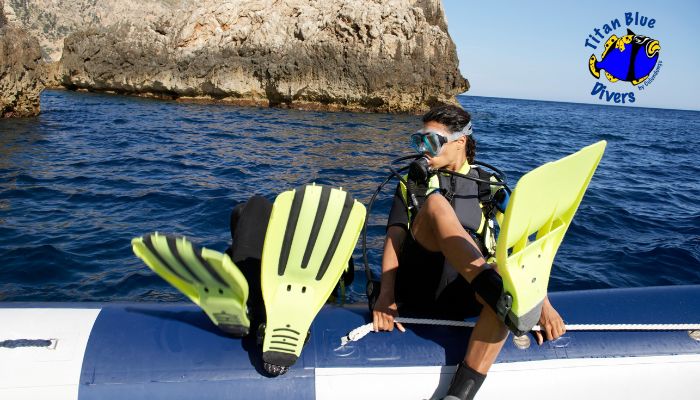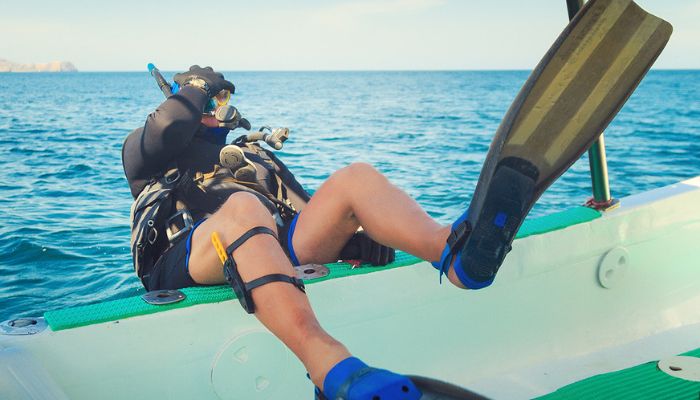
Why do divers dive on their backs?
If you are just starting your adventure as a diver or you are already a diving enthusiast, you have probably wondered why divers dive on their backs. Is this the only way to enter the aquatic environment? What are the advantages?
In this article, we will reveal all the secrets of this widely used technique and give you valuable tips on how to master it like a true expert.
From its advantages and uses to common mistakes to avoid, here you will find everything you need to know to make a safe, comfortable and stylish entry into the water.
Get ready to dive into a fascinating underwater journey as we unravel the mystery of why divers dive on their backs!
Why Do Divers Dive on Their Backs? The Technique Explained
La técnica de tirarse de espaldas, también conocida como «entrada de espaldas», es una habilidad esencial en el buceo que consiste en ingresar al agua desde una embarcación o plataforma saltando hacia atrás y dejando que el cuerpo se sumerja de manera controlada.
This technique is widely used because of its many benefits. By jumping backwards, the diver avoids hitting the diving equipment against the boat, which reduces the risk of damage or injury. In addition, it allows the equipment to be carried comfortably and safely, since being on your back, it is in a vertical position and securely fastened.
Back entry is especially useful when the boat is in motion, as it allows you to adapt to the movement and enter the water in a balanced and controlled manner.
It is also a preferred technique in open water, where there is no shore nearby, as it facilitates quick and efficient entry into the water.
When diving in caves or in conditions of strong currents, the technique of back diving offers stability and control during the dive. By entering vertically, the diver can maintain a proper position and avoid being swept by the current, which is critical in challenging environments.
When it comes to understanding why divers dive on their backs, it is important to note that doing so requires some practice and mastery. In the following sections we will guide you with a step-by-step guide to successfully apply the technique.

Advantages of Diving on Your Back for Diving
The technique of diving on your back has numerous benefits in diving. Below, we detail their advantages one by one:
- Allows you to carry your diving equipment comfortably and safely.
- Avoids hitting the equipment against the vessel, reducing the risk of damage or injury.
- It is especially useful when the boat is in motion, allowing it to adapt to the movement and enter the water in a balanced and controlled manner.
- Facilitates fast and efficient entry into open water, without a nearby shore.
- Provides stability and control during cave diving or in strong current conditions.
- Helps to maintain a proper position and avoid being swept away by the current.
- It is a preferred technique in challenging situations where vertical entry is required.
- Provides a smooth and controlled entry into the water, minimizing impacts and splashes.
Steps to Correctly Perform the Back Throwing Technique.
If you have wondered why divers throw themselves backwards out of the boat, it is possibly because you are interested in applying this famous technique to your dives.
Therefore, if you want to learn how to dive backstroke like a pro, pay attention to the following steps:
- Position yourself on your back on the boat or platform, making sure you have enough space for the jump.
- Cross your arms over your chest to secure the equipment and keep it in place.
- Lean back while maintaining balance and stability.
- Gently push yourself backwards, arching your body and bending your knees to enter the water in an upright position.
- Keep eyes closed during entry to protect them from possible splashes or impacts.
It is necessary that you practice this technique in a safe environment and under the supervision of an experienced diving instructor.
By receiving feedback and corrections from a specialist, you will be able to hone your skills and gain the confidence to perform the backstroke smoothly and safely.
Common Back Throwing Mistakes and How to Avoid Them.
Although the technique of diving on your back is relatively simple, there are some common mistakes that beginner divers often make. Here's what they are so you can avoid them:
- Do not keep your arms crossed over your chest: If your arms are loose, they can hit diving equipment or get caught on ropes or other objects, which can cause injury or equipment damage. Remember to keep your arms tightly crossed throughout the entire water entry process.
- Failure to maintain balance when leaning back: It is important to distribute your weight evenly and keep your center of gravity under control. If you lean too far back without proper balance, you can lose control and enter the water unbalanced. To avoid this, practice balancing and leaning gradually, adjusting to the sensation and maintaining a stable posture.
Remember that constant practice and error correction will help you improve your skills. Don't be discouraged if you find it a little difficult at first; with time and experience you will master it to perfection.

Are There Other Techniques for Entering the Water?
Yes! It is true that the technique of diving on your back is widely used, but there are also other ways to enter the water that divers can consider depending on the circumstances.
Let's look at some alternatives:
- Shore entry: In some places, such as beaches or lakes, it is possible to enter the water by walking from the shore. This option may be convenient when a boat is not available nearby or when sea conditions are not favorable for the backstroke technique.
- Kneeling entry: In shallow water or rocky bottoms, some divers opt to enter the water on their knees. This technique involves kneeling on the bank or platform and gently sliding forward until the water covers the body sufficiently to begin the dive.
- Standing entry: In certain situations, such as on piers or raised platforms, divers may choose to enter the water standing up. This technique requires taking a forward leap and making sure to maintain proper posture when entering the water.
It is important to keep in mind that each form of water entry has its specific advantages and considerations.
Divers should evaluate environmental conditions, depth, visibility and personal comfort before deciding which technique to use.
Now that you know why divers dive on their backs, you are ready to make the most of your dives. Remember that this technique gives you comfort, safety and stability when entering the aquatic environment.
However, it is also important to remember that the backstroke technique is not the only option available. There are other ways to enter the water that may be better suited to certain situations that we mentioned earlier.
Our recommendation is that you explore different techniques and discover which one best suits your needs and preferences. Remember that practice and experience will allow you to master them and become a more versatile and safe diver.
Hey! And if you are interested in learning more about scuba diving or improving your skills, you can do so with Titan Blue Divers certified scuba diving courses in Lanzarote.
Our team of instructors will be happy to accompany you in your underwater adventure, guiding you with the knowledge and skills necessary to enjoy this exciting activity in a safe and responsible manner.
Dive into the fascinating world of scuba diving and discover a universe full of life and adventure! Are you ready to dive into this incredible experience? Go ahead, the magic of the ocean awaits you!

